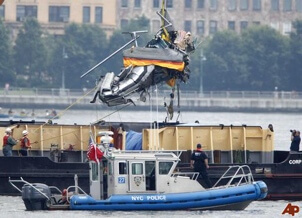Right about the time I left my last duty assignment, air traffic controllers started showing up in the news. My transfer to a new command is a good thing. Controllers in the headlines is usually not.

Hudson River midair recovery from Sulekha.com
Changes in military assignment can involve moving and/or other travel, schools or training, and general mayhem as families try to squeeze in vacation and quality time. You can imagine some things fall off the personal radar during this time. SaferAviator has been one of those things for me and it will be on the back burner for a few more weeks. My apologies to all of you for my silence.
Controllers, on the other hand cannot simply apologize for
letting something slip as errors often put lives at risk. Exhibit A: Two planes assigned the same altitude for opposite courses over the Pacific. TCAS saved 590 lives. Exhibit B: A controller was forced to change his instructions to a United flight departing Houston when he realized an error had been made. (Certain “facts” I’ve seen in news one this one don’t add up.) 300 lives were at risk. Exhibit C: In 2009, a midair between a private plane and a tour helicopter took 9 lives. The controller involved in this accident recently returned to duty in Virginia. (Watch for a future post on this accident.)
Part of my transfer involves attending one of the Department of Defense schools on aviation safety investigations. The US military is already one of the safest aviation organizations in the world, but to take it to the next level requires getting ahead of accidents by identifying what will cause the next one instead of what caused the last one. Part of this effort is use of a something called Human Factors Analysis and Classification System or HFACS. I’ve mentioned HFACS before and won’t assault you with a full explanation, but it’s used to classify the ‘why’ behind the ‘what’ and ‘how’ it occurred. If an organization can identify the why and fix it, we’re much less likely to have a need to ask how again.
Applying the HFACS concept to the three ATC issues above, we can ask why mistakes were made as soon as we know the how. NTSB is still investigating so I can only speculate, but do so carefully because I don’t have any more facts than you do. Over the Pacific, perhaps one of the flight crews asked for a different altitude that they planned for smoother air and controllers in adjoining sectors were not aware. In Houston, there are 4 VHF and 2 UHF Tower frequencies for the 5 runways. Could the two aircraft have been talking to different Tower controllers on different frequencies? Did one of the aircraft delay their takeoff roll, disrupting spacing? Over the Hudson, the controller blamed was permitted by his supervisor to regularly make non-pertinent phone calls during his shift and such a call was causal.
I’m not absolving the controllers. Just pointing out no controller starts their shift with the intent to make a mistake and put lives at risk. The three events above also show there may have been or were factors contributing to controller error.
Next time your hear about an accident or incident look beyond who did what to ask how and why. Answering and solving the ‘why’ is the way to reduce accident rates for any organization and is particularly important for general aviation. The question is, how do we apply the solution to all of GA?
Image from Selukha.com http://newshopper.sulekha.com/ye-hudson-mid-air-collision_photo_1092231.htm
HFACS link leads to Skybrary.aero http://www.skybrary.aero/index.php/Human_Factors_Analysis_and_Classification_System_(HFACS)
